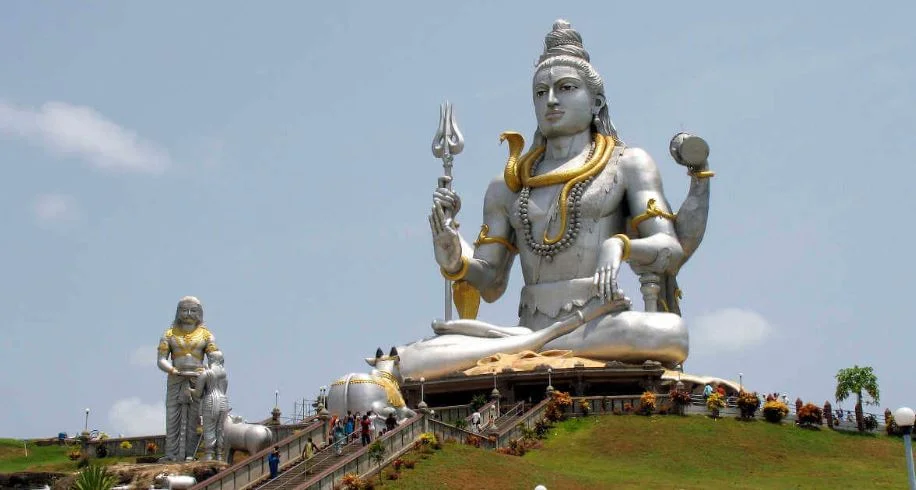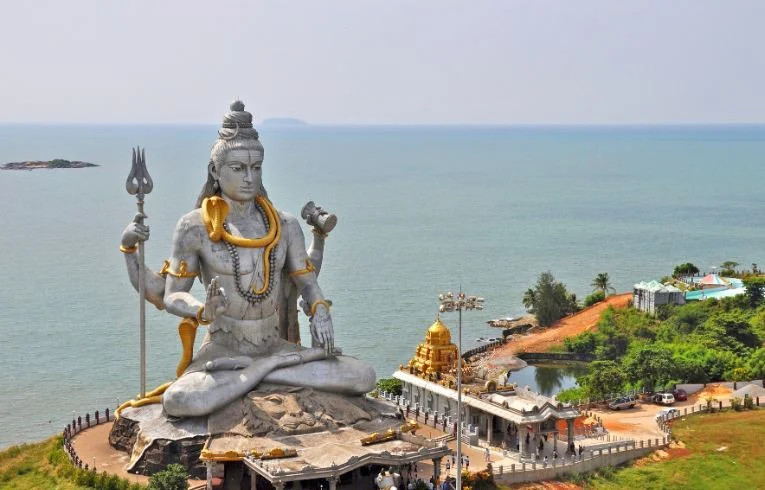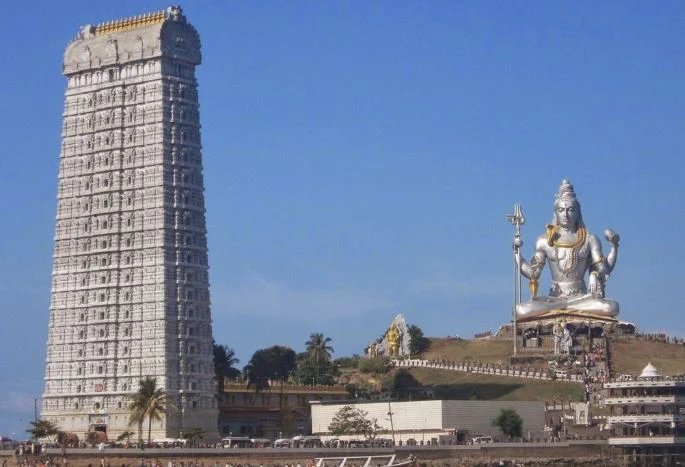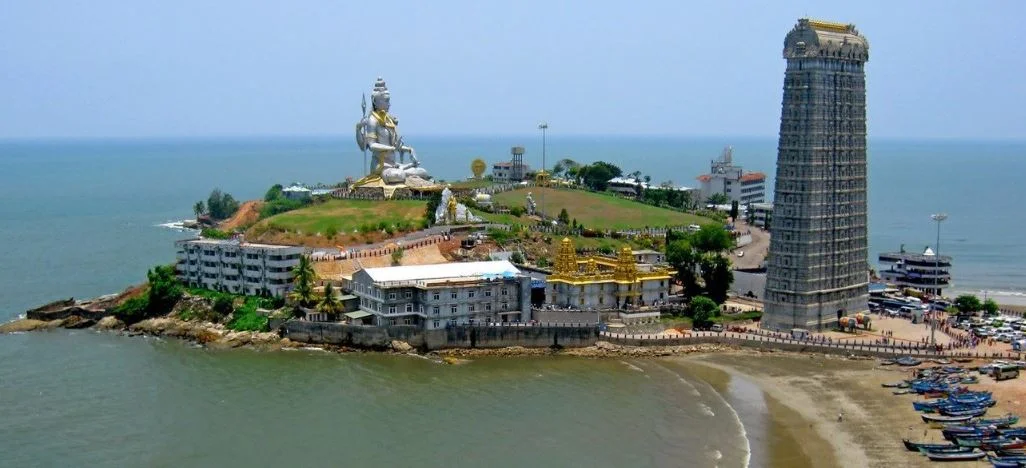The Murudeshwar Temple is a revered Hindu temple dedicated to Lord Shiva, located in Karnataka. Here are 18 Facts About Murudeshwar Temple.
Murudeshwar Temple is situated on Kanduka Hill, overlooking the Arabian Sea. It is located in the town of Murudeshwar in the Uttara Kannada district of Karnataka, India. It is known for its majestic architecture, picturesque location, and religious significance.
It is believed to be built on the spot where Lord Shiva is said to have appeared as a lingam (a symbol of divine energy) to bless the demon king Ravana. The main attraction of the temple is the towering statue of Lord Shiva, which stands at a height of around 123 feet (37 meters), making it one of the tallest statues of Lord Shiva in the world.
The temple complex includes various shrines, halls, and a peaceful meditation area. The serene surroundings, with the Arabian Sea as a backdrop, create a serene and spiritual atmosphere for devotees and visitors.
Facts About Murudeshwar Temple

Here are 18 interesting facts about Murudeshwar Temple.
1. Where is Murudeshwar Temple Located?
Murudeshwar Temple is located in the town of Murudeshwar in the Uttara Kannada district of Karnataka, India.
Murudeshwar is located approximately 160 kilometers from Mangalore and is well-connected by road and rail. The town is also known for its beautiful beaches and is a popular tourist destination.
- It is situated on the Arabian Sea coast, surrounded by scenic beauty and breathtaking views.
- The temple is dedicated to Lord Shiva and is one of the most prominent pilgrimage sites in South India.
- It is famous for its towering gopuram (entrance tower), which stands at a height of 249 feet (76 meters), making it one of the tallest temple towers in the world.
The temple complex also houses a colossal statue of Lord Shiva, attracting devotees and tourists alike.
2. Mythological Facts of Murudeshwar Temple
The origin of the Murudeshwar Temple dates back to ancient times, with references in Hindu mythology and epic tales.
- According to legends, the temple is believed to have been visited by Lord Rama during his search for his wife, Sita.
- It is said that Lord Rama offered prayers to Lord Shiva at this very spot before crossing the sea to rescue Sita from the demon king Ravana.
The temple’s historical and mythological significance adds to its spiritual aura and draws devotees to seek divine blessings.
3. Magnificent Shiva Statue

The Murudeshwar Temple is famous for its grand statue of Lord Shiva, known as the “Murudeshwar Statue” or “Shiva Statue.”
- The statue stands at a towering height of 123 feet (37 meters), making it one of the tallest statues of Lord Shiva in the world.
- It is located on a small hill called Kanduka Giri and overlooks the Arabian Sea, creating a mesmerizing sight for visitors.
- The statue is intricately carved and portrays Lord Shiva in a standing posture, with his trident and a cobra adorning his neck.
The majestic Shiva Statue has become an iconic symbol of Murudeshwar and a major tourist attraction.
4. Architectural Facts of Murudeshwar Temple
The Murudeshwar Temple showcases exquisite Dravidian-style architecture, characterized by intricate carvings and ornate structures.
- The temple’s gopuram (entrance tower) is a masterpiece of craftsmanship, adorned with detailed carvings of gods, goddesses, and mythological figures.
- The temple complex features beautifully carved pillars, mandapas (assembly halls), and a Sanctum sanctorum dedicated to Lord Shiva.
The intricate artwork and architectural grandeur of the temple reflects the rich cultural heritage of the region.
5. Sanctum Sanctorum
The sanctum sanctorum of the Murudeshwar Temple houses the main deity, a lingam (a symbolic representation of Lord Shiva).
- The lingam is believed to be a Swayambhu (self-manifested) form, with a natural impression of a cow’s head on it.
- Devotees offer prayers and perform Abhishekam (ritualistic bathing) to the lingam as a form of worship.
- The sanctum sanctorum creates a serene and sacred ambiance, allowing devotees to experience a deep sense of spirituality and devotion.
The temple rituals and prayers conducted in the sanctum sanctorum follow ancient traditions and attract a large number of devotees.
6. Maha Shivaratri Celebrations
Maha Shivaratri, the great night of Lord Shiva, is celebrated with great fervor at the Murudeshwar Temple.
- Devotees from far and wide gather at the temple to seek the blessings of Lord Shiva on this auspicious occasion.
- Elaborate rituals, special pujas (prayers), and cultural performances are organized throughout the night.
- The temple complex is beautifully illuminated, creating a mystical atmosphere.
The Maha Shivaratri celebrations at the Murudeshwar Temple offer a unique spiritual experience for devotees.
7. Raja Gopura

Apart from the main gopuram, the temple complex also features another prominent structure known as the “Raja Gopura.”
- The Raja Gopura stands at a height of 237 feet (72 meters) and is adorned with intricate carvings and sculptures.
- It provides a majestic entrance to the temple complex and adds to its architectural grandeur.
- Visitors can climb to the top of the Raja Gopura through a series of steps to enjoy panoramic views of the surrounding landscape.
The Raja Gopura has become a symbol of pride for the Murudeshwar Temple and a must-visit attraction for tourists.
8. Murudeshwar Beach

The Murudeshwar Temple is located on the shores of the Arabian Sea, offering access to the scenic Murudeshwar Beach.
- The beach is known for its pristine beauty, golden sand, and clear blue waters.
- Visitors can enjoy leisurely walks along the shoreline, indulge in water sports, or simply relax and admire the natural splendor.
- The beach also provides a picturesque backdrop for the temple and the Shiva Statue, enhancing the overall charm of the site.
Murudeshwar Beach is a popular spot for tourists to unwind and immerse themselves in the tranquil ambiance.
9. Gopura Darshana
The Murudeshwar Temple complex offers a unique and captivating experience known as “Gopura Darshana.”
- Gopura Darshana allows visitors to witness the daily changing of the temple flag atop the gopuram.
- Devotees and tourists gather at a designated viewpoint to observe the ceremonial raising and lowering of the flag.
- The event is accompanied by the chanting of prayers and the playing of traditional musical instruments.
Gopura Darshana is considered an auspicious moment, and witnessing it is believed to bring good luck and blessings.
10. Historical Significance
- The region around the Murudeshwar Temple has a rich historical heritage.
- It is believed to have been an important center of trade and maritime activities during ancient times.
- The temple’s location near the Arabian Sea made it a significant port for international trade, connecting India with other civilizations.
- The historical importance of the region is reflected in the architecture, sculptures, and inscriptions found in and around the temple complex.
- The temple stands as a testimony to the historical and cultural significance of the area and attracts history enthusiasts.
11. Ratha Yatra Facts of Murudeshwar Temple
The Murudeshwar Temple celebrates an annual chariot festival known as the “Ratha Yatra.”
- During the festival, the deities of Lord Shiva and Goddess Parvati are placed on beautifully decorated chariots.
- Devotees enthusiastically participate in pulling the chariots through the streets, accompanied by music and devotional chants.
- The Ratha Yatra is a vibrant and joyous celebration that brings together the local community and devotees from different parts of the region.
It is an opportunity for devotees to express their devotion and witness the divine journey of the deities.
12. Murudeshwar Temple Museum

The temple complex houses a museum dedicated to showcasing the rich heritage and history of the region.
- The Murudeshwar Temple Museum displays a vast collection of sculptures, artifacts, and relics related to Hindu mythology and temple architecture.
- Visitors can explore the museum to gain a deeper understanding of the cultural and artistic traditions associated with the temple.
- The museum provides insights into the evolution of temple architecture and the significance of various deities worshipped in the region.
It serves as an educational and informative space for both locals and tourists interested in the temple’s history and cultural context.
13. Nandikeshwara Temple
Adjacent to the Murudeshwar Temple is the Nandikeshwara Temple, dedicated to Lord Shiva’s Vahana (divine vehicle), Nandi the bull.
- The temple features a massive statue of Nandi, measuring around 25 feet (7.6 meters) in height and 30 feet (9.1 meters) in length.
- The intricately carved Nandi statue is a significant attraction for devotees and art enthusiasts.
- The temple also houses smaller shrines dedicated to other Hindu deities, creating a serene and divine atmosphere.
Devotees offer prayers to Nandi seeking blessings for strength, devotion, and spiritual upliftment.
14. Statue of Lord Ganesh
Within the temple complex, there is a statue of Lord Ganesh, known as the “Ganesha Statue.”
- The statue is placed near the entrance and is intricately crafted, depicting Lord Ganesh in a seated posture.
- Devotees offer prayers to Lord Ganesh before entering the main temple premises, seeking his blessings for success and auspicious beginnings.
- The presence of Lord Ganesh adds to the divine energy and spiritual significance of the Murudeshwar Temple complex.
Visitors can also admire the artistic brilliance and attention to detail in the sculpture of Lord Ganesh.
15. Scenic Surroundings and Panoramic Views
The Murudeshwar Temple is nestled amidst picturesque surroundings, offering breathtaking views of the Arabian Sea and the coastal landscape.
- Visitors can explore the temple complex and find vantage points to enjoy panoramic views of the sea, the temple structures, and the Shiva Statue.
- The serene ambiance and natural beauty of the surroundings create a tranquil atmosphere conducive to meditation and introspection.
- The temple’s location on a hill and its proximity to the beach make it a perfect place to witness mesmerizing sunsets and soak in the serenity of the surroundings.
The combination of architectural splendor and scenic beauty makes the Murudeshwar Temple a popular destination for photography enthusiasts.
16. Dharmasthala
Dharmasthala, located near the Murudeshwar Temple, is an important pilgrimage site in Karnataka.
- It is known for the Dharmasthala Temple dedicated to Lord Manjunatha, an incarnation of Lord Shiva.
- Dharmasthala is renowned for its religious and philanthropic activities, providing free food and accommodation for pilgrims.
- Many devotees visiting the Murudeshwar Temple also include a visit to Dharmasthala in their itinerary.
- The close proximity of these two significant temples makes the region a popular pilgrimage circuit in Karnataka.
17. Festivals Facts of Murudeshwar Temple
The Murudeshwar Temple celebrates various festivals throughout the year, attracting a large number of devotees.
- Apart from Maha Shivaratri and Ratha Yatra, other important festivals celebrated at the temple include Navaratri, Diwali, and Kartik Purnima.
- During these festivals, the temple complex is adorned with colorful decorations and vibrant lights.
- Special rituals, cultural performances, and processions are organized, creating a festive atmosphere.
The festivals provide an opportunity for devotees to immerse themselves in devotion, experience traditional customs, and seek the blessings of the deities.
18. Underwater Shiva Statue of Murudeshwar Temple
One fascinating feature of the Murudeshwar Temple is the unique underwater Shiva statue located near the temple complex.
- This statue, known as the “Underwater Shiva,” is installed at a distance from the shore, beneath the surface of the Arabian Sea.
- The statue is positioned in such a way that it appears as if Lord Shiva is standing amidst the sea, blessing devotees and protecting the coast.
- It serves as a major attraction for scuba divers and snorkelers who can explore the underwater world while witnessing the divine presence of Lord Shiva.
The underwater Shiva statue adds an element of mystique and adventure to the spiritual journey of visitors and showcases the artistic vision of the temple authorities.
Related Posts
- 21 Facts About Vaishno Devi
- 19 Facts About Amarnath
- 21 Facts About Kedarnath
- 27 Facts About Badrinath
- 16 Facts About Gangotri
- 17 Facts About Yamunotri
